Joy Neal Kidney's Blog, page 60
December 7, 2021
The Attack on Pearl Harbor, Territory of Hawaii, 80 Years Ago
Pearl Harbor, Territory of Hawaii
December 7, 1941. In a gold waitress uniform, Doris Wilson served Sunday dinner to the after-church crowd at McDonald’s Drug store in Perry, Iowa. A hint of Evening in Paris perfume permeated the store, where it was also sold. Doris worked at the soda fountain there, but after church on Sundays, she was kept busy in the restaurant section.
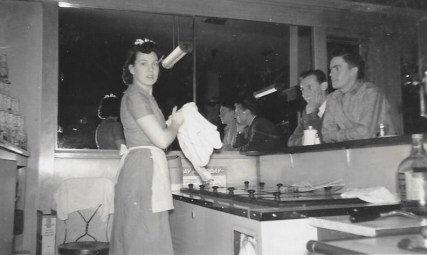 Doris Wilson at the soda fountain section, McDonald’s Drug Store, Perry, Iowa, 1940s
Doris Wilson at the soda fountain section, McDonald’s Drug Store, Perry, Iowa, 1940sSammy Kaye’s Sunday Serenade provided background music over WHO Radio. A news bulletin interrupted the music: The Japanese had bombed Pearl Harbor.
The restaurant grew quiet. “The Japs? Why would they bomb Pearl Harbor?” someone asked.
“Does this mean we’re at war?”
“Where is Pearl Harbor anyway?” asked another.
“Hawaii,” Doris said. “I’m afraid this does mean war. And my brothers are all the wrong ages.”
“How many brothers do you have?”
“Five. Donald is already in the Navy. His ship was stationed in Pearl Harbor a few months ago. He said we shouldn’t trust the Japanese, and he was right.”
Thank God Donald had jumped ship a couple of weeks earlier to return to the Minburn farm to see the family. With war breaking out for real, who knew when they’d all be together again?
And thank God Danny was too young to be drafted, and Junior was still in high school at Washington Township School. But Delbert would probably be recalled by the Navy, and Dale had already registered for the draft. Donald wasn’t safe in the Atlantic either. Doris feared for all five brothers.
The family photograph taken at Edmonson’s Photo in Perry while Donald was home, eighty years ago, was the last one ever taken. It was the last time the whole family was together. Soon, Delbert was back in the Navy, and Dale joined the US Army Air Force as a cadet.
 Last photo of the Wilson family, November 1941, Perry, Iowa: Seated: Clabe and Leora. Standing: Danny, Darlene (Wilson) Scar, Donald, Junior (still in high school), Delbert, Doris, Dale
Last photo of the Wilson family, November 1941, Perry, Iowa: Seated: Clabe and Leora. Standing: Danny, Darlene (Wilson) Scar, Donald, Junior (still in high school), Delbert, Doris, DaleIn just a few months, Donald Wilson, on the crew of the famous USS Yorktown, would be in major battles with the Japanese in the Pacific, barely escaping with his life.
One by one the Wilson brothers volunteered until all five had left the Minburn farm to serve in the war.
President Roosevelt had made a prophecy back in 1936, “There is a mysterious cycle in human events. To some generations much is given. Of other generations much is expected. This generation of Americans has a rendezvous with destiny.”
He was right. And so was Doris’s premonition.
That generation of the Wilsons, having endured poverty during the worldwide Depression, was destined to suffer the anguish of losing three brothers during a world war.
—–
Leora’s Letters: The Story of Love and Loss for an Iowa Family During World War II is the family’s WWII story, and also the story behind the five Wilson brothers who are featured on the Dallas County Freedom Rock at Minburn, Iowa.
December 4, 2021
The Left-Handed Girl
Old-time writing paper from the 1920s, creases from being folded to take home. A traced star at the top, neatly colored yellow. Her name in the upper left, in cursive writing: Doris Wilson.
I see the stars in the sky./ They twinkle twinkle in the night./ Once a bright shining stars [sic] was seen/ It led the wis [sic] men to the stable./ They found the little Christ Child./ This was our first Christmas.

This reminds me of one of my mother’s stories. The first graders in the Dexter, Iowa, school learned to write in their letters in cursive right away. The teacher asked whether anyone in the class could show them how to make the letter S. Doris raised her hand. “Yes, Doris. You have an “s” in your name. Please come up and write it on the blackboard.”
Doris nervously walked to the front and picked up the chalk–with her left hand. As soon as she started to write, several children in the class began to snicker. Was it was because she’d used the “wrong” hand? She was the only left-handed student in the class.
In those days, and even for several decades, schools tried to get left-handed students to change to using their right hands. Or they taught them to write with their left hand curved above the writing so that slant of their letters would match that in the penmanship books. Children were graded on their writing, which made for lots of beautiful and readable papers and letters.
Beautifully written papers were even posted in the classroom. My mother remembered one of hers honored that way, with a note added by Miss Overton, “Left handed.”
At home, the kids took turns working a hand grinder–maybe to grind meat or to make piccalilli from vegetables at the end of the garden growing season. Doris took a turn, starting out cranking with her right hand like the others. She soon switched to her left, announcing that she worked better when she used her “father hand.”
My 4-H Project
I never thought about left-handedness being different until Mom helped me with a 4-H project. Each year we had to give a talk to our local club, and also a demonstration. Leaflets gave ideas of topics, and one year I decided to give a demonstration on how to make slipper socks out of a pair of men’s Rockford socks, with the red heel and toe. You were to cut sturdy cardboard to fit in the socks, then stitch it in as a sole. (I never asked how you were supposed to launder them!) I needed one pair to show the completed project, and another to demonstrate with.
I quickly learned how difficult it was to cut cardboard with scissors. Mom offered to help, but when she finished, he left hand was numb because scissors were built for right-handers. Later we found her left-handed scissors, the first she’d ever had.
Ironing wasn’t much of a problem. We just turned the ironing board around, or stood on the opposite side. It wasn’t until I got married that I discovered that I hung my clothes left-handed, just like we did at home.
Mom Played Basketball
Being left-handed was an asset for my mother when she was in high school. She made the basketball team as a freshman. Why? Because she shot baskets with her older brothers.
And because, she admitted in her later years, “I was a lefty.”
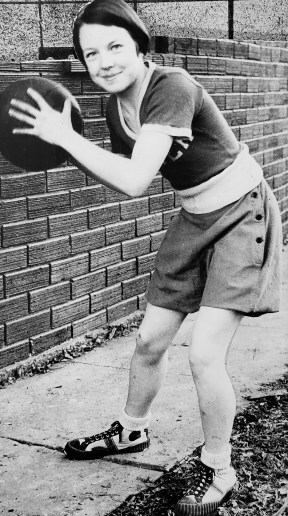 Dexter freshman Doris Wilson The Des Moines Tribune, January 10, 1933 © USA TODAY NETWORK
Dexter freshman Doris Wilson The Des Moines Tribune, January 10, 1933 © USA TODAY NETWORK
December 2, 2021
Two New WWII Historical Novels
Where Shall I Flee?
Anne Clare
 Lieutenant Jean Hoff of the U.S. Army Nurse Corps and infantryman Corporal George Novak have never met, but they have three things in common. They are both driven by a past they’d rather leave behind. They have both been sent to the embattled beachhead of Anzio, Italy. 1944.
Lieutenant Jean Hoff of the U.S. Army Nurse Corps and infantryman Corporal George Novak have never met, but they have three things in common. They are both driven by a past they’d rather leave behind. They have both been sent to the embattled beachhead of Anzio, Italy. 1944.
And when they both wind up on the wrong side of the German lines, they must choose whether to resign themselves to captivity or risk a dangerous escape. The story follows their journey through the dangers of World War II Italy, where faith vies with fear and forgiveness may be necessary for survival.
What a suspenseful story, on several levels–physical, emotional, psychological! You tend to forget about nurses’ contributions to the war effort, this one in Italy. But her service was cut short when she’s the only woman caught with soldiers behind enemy lines. Day by day they face dangers while trying to return to the Americans. One of the German doctors is an especially interesting character, as is a scene where an unusual tea is served up. An absorbing WWII novel.
This awesome author-mom-teacher-musician also completed writing 50,000 last month for NaNoWriMo! She challenged her students to do the same, so an extra incentive. Wow!
Anne Clare’s Amazon Author Page. She also has a website.

Land That I Love
Gail Kittleson
 Set in the German Hill Country of Texas during World War II, the book deals with love and loss, friendship and animosity, fathers and sons, and coping during times of war and peace. As the characters struggle with the problems of everyday life, they teach us that we survive hard times by being good neighbors despite our differences and that hatred can be conquered by love, understanding and forgiveness.
Set in the German Hill Country of Texas during World War II, the book deals with love and loss, friendship and animosity, fathers and sons, and coping during times of war and peace. As the characters struggle with the problems of everyday life, they teach us that we survive hard times by being good neighbors despite our differences and that hatred can be conquered by love, understanding and forgiveness.
What a masterful story, rich in history (the war, but also Texas and the Hill Country), rich in exploring mental illness, the power of place, and rich in language.
Of all of Gail Kittleson’s several WWII historical novels, this one is my favorite.

Gail’s Amazon Author Page. Her Women of the Heartland series. Here’s Gail’s website.
November 29, 2021
The Compelling Stories of Paul Kotz
I was “introduced” to the winsome storytelling of Paul Kotz through Our American Stories.
That led to my buying and enjoying his first two books. The third has just been published. Their short surprising stories would be so welcome as Christmas gifts.
Paul believes that a friend is just a “hello” away, or even just making eye contact with someone.
Start Late, Finish Happy: Random Encounters–Unexpected Joy
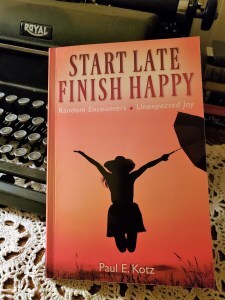
This is Paul Kotz’s newest book. His winsome vulnerability attracts all sorts of people, including his students. I was drawn to this Minnesotan’s gentle stories, such as conversations while taking his mother for regular eye appointments, and encounters with clerks in various shops.
An encourager extraordinaire, the author deliberately seeks to be kind, to listen and hear, to be more comfortable with the uncomfortable, and to deal with loss, especially since these latest reflections have been set in these months of dealing with Covid.
At the end are “A Little Extra Motivation” and “Last Advice,” both lists of wisdom and whimsey, which are precursors to happiness.
—–
Something Happened Today: A Collection of the Unexpected

Gentle observations and nudgings, even while discussing death in a hot tub (which the author did not instigate).
Chapters: Everyday Gifts, Everyday Life, Growing Up, Kindness, Society Today, Mentoring, Unexpected Surprises. There’s also Advice and Perspectives at the end.
Paul is vulnerable and open about his thoughts, acknowledging that “practice may not lead to perfection, but it could lead to new insight.” His stories are full of nuggets of wisdom.
His motto: Fair, firm, friendly. Paul Kotz is the kind of man you hope will teach or mentor your kids and grandkids.
—–
Profiles in Kindness: Stories of Inspiration & Everyday Leadership

Chapters are Eye-Openers, New Insights, Inspiration, Everyday Life, and Leadership.
All the essays are short, encouraging in sympathetic ways, recognizing that each person has relevance, and that discouragement and failings happen because we all are human beings.
Besides a full-time job, Paul also volunteers at the veterans’ home in Minneapolis. Some of his reflections are from encounters there, even one about the curmudgeon who says that Paul ruins the day by being so ugly!
—–
 Dr. Kotz is a lifelong learner with education and business expertise. This includes working as faculty and advisor with undergraduate, graduate students and since 2013, in a doctoral program in leadership. Kotz has taught and served as an executive coach to graduate students and business professionals; and has assisted high school students in navigating adolescence. A resident of St. Paul, Minnesota, he continues to collect new experiences that shape and challenge his perspectives.
Dr. Kotz is a lifelong learner with education and business expertise. This includes working as faculty and advisor with undergraduate, graduate students and since 2013, in a doctoral program in leadership. Kotz has taught and served as an executive coach to graduate students and business professionals; and has assisted high school students in navigating adolescence. A resident of St. Paul, Minnesota, he continues to collect new experiences that shape and challenge his perspectives.
Paul’s Amazon Author Page. He is a regular storyteller on Our American Stories–click for all of them. One is such an unexpected story about playing cards with a stranger-become-friend in a dumpster!
November 25, 2021
The First Thanksgiving was 400 Years Ago
We all know the story of Thanksgiving. A hundred Pilgrims came over on the Mayflower, stepped out on Plymouth Rock with their buckled shoes and were greeted by Indians who proceeded to teach them to plant corn with fish. They had a big Thanksgiving dinner with turkey, cranberry sauce, and pumpkin pie with Cool Whip. Right?
A newspaper once noted that Thanksgiving is “a holiday that has no religious affiliation,” and that the whole tradition centers around food. School children are taught that it celebrates how nicely the Pilgrims and Indians got along.
But the Pilgrims’ faith in God is why we celebrate any of it.
Holland
John and Joan Tilley believed that the Church of England did not teach God’s word as they found it in their Bible. They were required to attend Anglican services, but they also met with other believers to study the Bible, which was against the law. So when their daughter Elizabeth was a toddler, they fled to Holland with other English Separatists.
Though the Dutch were tolerant, they were more bawdy and did not observe the Sabbath. And the English children, like Elizabeth Tilley, started speaking Dutch and becoming more like them.
So, after a dozen years in Holland, a band of Pilgrims decided to establish an English colony in the new world. Two ships set sail in August of 1620, but one began to leak so they turned back. It was left behind.
Forty Separatists (including Tilleys) and sixty-some others–recruited by London businessmen financing the trip–crowded onto the Mayflower, finally embarking September 20.
These pilgrims risked their lives to plant a colony for the “glory of God, and advancement of the Christian faith and honor of our King and Country” in the new world. During the 65-day trip, they ran into a storm. When the crowded conditions became unbearable, John Howland, an indentured servant, climbed to the deck for fresh air. He was washed overboard!
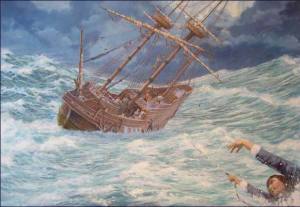
Luckily for us descendants, Howland got caught in the halyards and was rescued.
New World
By the time the tired band finally spotted land, one person had died and a new baby born. One hundred two souls arrived. The Mayflower dropped anchor off Cape Cod, where 41 men signed “The Mayflower Compact”–-the first agreement for self-government and rule of law in the new world.
Our nation’s foundations are undergirded by the faith of this handful of hardy believers.
That first winter about half of them died while they were anchored off Provincetown, Massachusetts. Both parents of thirteen-year-old Elizabeth Tilley died. So did her uncle, Edward Tilley, and his wife. Now an orphan, Elizabeth moved in with Governor and Mrs. Carver, along with two other girls. But before summer arrived, the Carvers had also died. No one knows who took in the girls.
When the Mayflower returned to England, just half the original number of Pilgrims watched it disappear from sight.
Thanksgiving
Of the eighteen Pilgrim wives and mothers who had left England, only five survived. By October, when the Pilgrims invited the Wampanoags to a harvest feast, four women and five teenage girls (three of them the sole survivors of their families) cooked and served what we now think of as the first Pilgrim Thanksgiving.
When I was fourteen, my family of four drove a few miles of Iowa’s gravel roads to a clan Thanksgiving dinner at Grandpa and Grandma Neal’s–twelve grownups and thirteen cousins. My sole duties the Thanksgiving of 1958 were to help carry food in from the car, and help do dishes afterwards. The rest of the time was spent in cousin-talk–about junior high, band, and basketball. One year I taught Cousin Ken to dance rock and roll in the farm house’s unfinished basement, right beside rows and rows of glass jars of Grandma’s summer canning.
 Back: Vince Wells, Ken Shepherd, Patty Wells, Gloria Neal. Middle: Joy Neal, Susan Shepherd, Judy Neal, Jon Shepherd, Jane Neal Front: Dawn, Jacque and Bill Beaman
Back: Vince Wells, Ken Shepherd, Patty Wells, Gloria Neal. Middle: Joy Neal, Susan Shepherd, Judy Neal, Jon Shepherd, Jane Neal Front: Dawn, Jacque and Bill BeamanQuite a contrast to our ancestor, Elizabeth Tilley’s Thanksgiving. When she was fourteen, she helped cook and serve a harvest feast–-venison, wild fowl, turkeys, Indian corn, and other foods–-for 48 Englishmen, plus 90 Wampanoags.
What we call the first Thanksgiving feast in America lasted three days!
When she was about seventeen years old, Elizabeth Tilley married John Howland–the man who survived being washed overboard, and who was the thirteenth signer of the Mayflower Compact..
John and Elizabeth Howland had ten children. Their descendants, including us Neals, are scattered all over the globe.
Thanksgiving is still my favorite holiday. Among so many other things, we thank God for family–even for that long-ago ancestor who as a teenager helped serve that first Thanksgiving feast 400 years ago.
Published in the Thanksgiving edition of The Des Moines Register, November 25, 2021:

November 22, 2021
Annual Dexter-Earlham Thanksgiving Gridiron Clash
The Dexter-Earlham Thanksgiving football rivalry had been going on for decades!
1915
 The signs in the back say DEXTER 6, EARLHAM 0. The whiner in the lower left is holding an Earlham pennant. November 25, 1915.
The signs in the back say DEXTER 6, EARLHAM 0. The whiner in the lower left is holding an Earlham pennant. November 25, 1915.1932

Doris wrote Del’s name on this one because he made the winning touchdown. It was Delbert and Donald’s last high school football game.
In a 1934 letter from Leora to her Navy sons, she said that her brother Jennings had mentioned that they still had the honor of winning the last game that year against Earlham, and that Delbert had made the last touchdown. “That was the best all around teamwork that was ever played that year, so they say.”
1933

1934
Delbert and Donald Wilson were in the Navy. Their ship, the USS Chicago, was stationed in Southern California, where the brothers got to spend Thanksgiving with aunts and uncles, but they made sure to ask about the annual Thanksgiving game.
Dale (age 13) wrote, “I’m telling you that it [the game] was no good. Earlham swamped Dexter 26 to 0, just as bad as Adel did. Well, I’ll tell you how it happened so as to give you an idea of the game.
“In the first quarter Earlham kicked off to Dexter. Paul Willrich caught the ball and went about ten yards and was down. Earlham held them and then it was their ball and made first in ten, and then first in ten until they made a touchdown.
“In the second quarter, Earlham and Dexter battled until the half, the score being 6 to 0.
“In the third quarter Earlham kicked off and Dexter was down. Then Dexter tried the triple crisscross and lateralled to Mervin Wells, which he fumbled and Earlham recovered the ball and then they made first in ten until they made another touchdown. Then they shot a pass over the goal which made the extra point. Then Earlham kicked off to Dexter again and Dexter made 25 yards after the kickoff. Then it was the quarter and they changed sides.
“In the fourth quarter Dexter made about 35 yds. until they were 20 yds. from the goal. Then Earlham held Dexter, Earlham punted right back to Dexter and the ball went back to the other goal, which went over Paul Willrich, the quarterback. He ran back to the goal and picked up the ball and was tackled on the goal lines. That punt of Earlham’s was a good one. Then Dexter punted and the punt was blocked and Earlham dived on the ball, which made another touchdown. Then Earlham tried for the extra point, which they didn’t make.
“Earlham kicked off to Dexter the fourth time and Dexter was tackled on the 45 yd. line. Then Earlham held them. And it was Earlham’s ball. Earlham made about 30 yds. and then Dexter held them. And it was Dexter’s ball. Dexter made about five yds. and then shot a pass, which Earlham intercepted and went around the end for another touchdown. Then they tried for the extra point and made it, making the score 26 to 0.”
Not even fit for a penny
Here was nine-year-old Junior’s take on the game:
“Dear Brothers,
“. . . . Yesterday there was a football game. The Earlham guys skunked the Dexter boys. It came out to 26 to 0 and the ballgame was no good. It wasn’t even fit for a penny. Well, I’ll tell you just how it happened. First quarter Earlham kicked off and Paul Willrich grabbed the ball. He started running a ways, in comes an Earlham guy. Paul Willrich standed there a while and then Earlham tackled him in the middle of the field. They get in their places and shiffs the ball. They shot a few laterals and they lose the ball and the Earlham guy got it and laid their awhile, then got up. They get in their places, they shiffs the ball, and they blocked and knocked Mervin Wells out, and went for their touchdown. Well, I guess that’s all I got to say now. The next time I write, I’ll have more news, so so long!”
Leora wrote, “Junior wanted to write as soon as he came in, and I think by the questions he asked about spelling, he is writing about the game. Dale is pretty good isn’t he, in explaining about the game. . . . Can you read Junior’s letter without laughing?”
1938

Dale Wilson played in this game, his last one as he graduated the next May. Donald was still in the navy at this point, and had even played some semi-pro football when his ship was in port, but there aren’t any letters from home saved from these months.
He mentioned that he’d like to see the annual game, and even see his younger brothers play on the Dexter team. He finally got to see a game, but not until November 1945, after World War II was over, and he came home for a visit with his wife Rose.
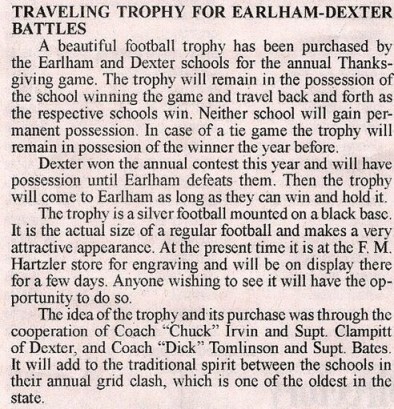 Wesley D. Clampitt, was Superintendent of the Dexter School during the years that the Wilson family lived at Dexter. He also was a classmate of Clabe Wilson at Guthrie County’s Frog Pond rural school.
Wesley D. Clampitt, was Superintendent of the Dexter School during the years that the Wilson family lived at Dexter. He also was a classmate of Clabe Wilson at Guthrie County’s Frog Pond rural school.I wonder where that attractive silver football mounted on a black base is stored today.
November 19, 2021
The Rescuer by Jason Sautel
Jason Sautel’s book, The Rescuer, is the most compelling book I’ve read recently. The author explains so well the emptiness, the darkness, the haunting of a broken past. He contrasts it so well with the light and peace that love and salvation bring.
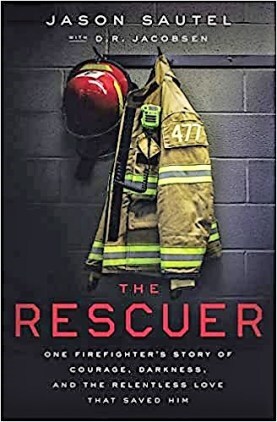
He helped save people every day—but he had no idea how to save himself.
Jason Sautel had it all. Confident in his abilities and trusted by his fellow firefighters, he was making a name for himself on the streets of Oakland, California. His adrenaline-fueled job even helped him forget the pain of his childhood—until the day he looked into the eyes of a jumper on the Bay Bridge and came face to face with a darkness he knew would take him down as well.
In the following months, a series of traumatic emergency calls—some successful, others impossible-to-forget failures—drove Jason deeper into depression. Even as he continued his lifesaving work, he realized he could never rescue everyone, and he had no idea how to save himself.
In the end, Jason was forced to confront the truth: only the relentless power of love could pull him back from his own deadly fall. Action-packed, spiritually honest, and surprisingly romantic, The Rescuer transports readers inside the pulse-pounding world of firefighting and into the heart of a man who needed to be broken before he could finally be made whole.
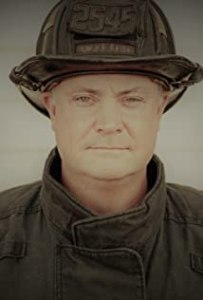
Jason Sautel spent much of his early adulthood as a decorated firefighter in one of the toughest firehouses in the country and today shares Christ-centered stories and lessons from his time there to his 600,000+ Facebook followers. He loves his wife of sixteen years, Kristie, his four two-legged children, his two four-legged children, and appreciates God’s gifts of donuts, surfing, and Maui.
Jason recently told his inspirational 33-minute story, “My PSTD had PSTD,” on Our American Stories.
November 17, 2021
The Treasure Map, The Compass, The Spyglass
Each book in “The Adventures of Niko Monroe” is set during Christmas. These YA Christian Science Fiction stories will appeal to both boys and girls. This senior citizen has really enjoyed the books as well! They’d make great Christmas gifts for kids.
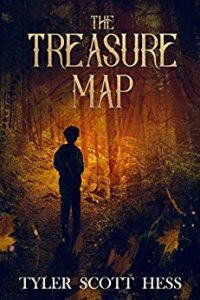
Is it possible for an escaped convict to be a hero? That’s the question asked by a boy who finds a map in an old trunk in the attic. Cleaning up the attic during Christmas break was punishment for less than stellar grades, but leads to a challenging mystery from an earlier time, connected to the boy’s ancestry. Boys and girls alike will be intrigued by this well-told and suspenseful story.
—–
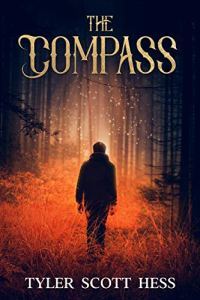 Jack Monroe is a fifth grader with a mystery under his bed, and a class project due after Christmas that he’s to complete with three others in his class, one of them a girl. The class project is to design a country with a history, culture, with people who’ll need jobs. But kids will be kids, and the author skillfully gives them unique and winsome personalities. Their assignment was a complex one.
Jack Monroe is a fifth grader with a mystery under his bed, and a class project due after Christmas that he’s to complete with three others in his class, one of them a girl. The class project is to design a country with a history, culture, with people who’ll need jobs. But kids will be kids, and the author skillfully gives them unique and winsome personalities. Their assignment was a complex one.
The mystery under his bed is also complex, in another country with its own history and culture, a young hero named Niko, and a small band of believers being used as pawns by two evil factions. This thread of the story is rich with human turmoil and symbolism, almost prophetic.
—–
The Spyglass (new this fall)
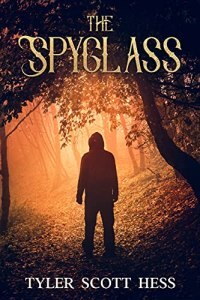
All three books in “The Adventures of Niko Monroe” trilogy include two worlds sharing the same timeline, come to a climax at Christmastime (the author’s favorite holiday).
Both threads are thought-provoking, with perils and uncertainty of survival fascinating enough to be enjoyed by both youthful readers and adults, all the while pondering whether they’d be as brave in similar situations.
—–
The author, Tyler Scott Hess, a Christmastime-loving father to three young daughters, has written other books as well. Check out his Amazon Author Page.
November 15, 2021
Autumn Poem, written in high school
Lucille Knapp, high school English teacher at Earlham, once assigned us to write a poem about autumn.
We were renting a house a couple of miles away from the big old farmhouse (AKA my childhood castle), which was being torn down. “Six rooms and a path,” as Grandma Leora would have called it, meaning a path to the outhouse. Yes, an outhouse.
This house had running water but no bathroom. The bedrooms were at the top of very steep stairs, and in the winter snow sifted across the bed my sister and I shared.
It was there that we got our first dial phone.
But when the poem was assigned, I’d envisioned pumpkins, russet and golden leaves, crisp blue skies, and the rustle of cornstalks. But it was rainy and chilly, with puddles along the path to you-know-where.
It ended up to be a rather bleak poem, unrhymed, and I sketched the carcass of a tree with it.
I was rather taken aback when Mrs. Knapp made a big deal out of this one gloomy poem out of the passel of cheerful ones.
—–
Autumn Poem
by Joy Neal, 1961
Close, sulfur-grey sky shifting, restless,
foreboding;
Dirty smoke billowing, diffusing, hovering.
Cold stone buildings stretching,
Pleading.
The unfriendly, bare-limbed oak
crouching in an alley, soggy with wet leaves;
so drab, gloomy, desolate.
Small miserable sparrows shiver in the damp air.
Water seeps from low hanging eaves.
Murky darkness closes about rapidly, quietly.
Slow drizzle slinks deep into old wood.
Hard cement for a pillow.
Piercing hunger–
piercing draft through slats.
Peering ahead to winter.
How much worse can it get?
It can’t last forever.
Hope
—–
Edited a little in 2021.
November 11, 2021
Veteran has been to all 99 of Iowa’s Freedom Rocks
 Brian Chung is the first “Full Freedom Rocker” or “Full 99er,” visiting the Freedom Rocks in all of Iowa’s 99 counties, that I know of. It’s officially known as The Freedom Rock Tour.This 20-year veteran of the Army National Guard has visited them on his Goldwing. He’s also taken a short video of several of them, walking all the way around and taking some of the surroundings, to share with the rest of us on Facebook.I “met” Brian because of The Freedom Rocks. He still had four of them to visit, and he got ‘er done before the snow flies! He commented on his Facebook page: “from May through the end of October I completed traveling to and capturing photos from all 99 Freedom Rocks. I put 10,000 miles on my Goldwing and have had interesting travels across all pf Iowa. Over the course of time I also watched Iowa grow through Spring and Harvest in the Fall. It has been a great adventure. A few days I did 500 plus miles in a day when the sun went down later in the Summer. I found it to be a special time riding, and at each Rock I tried to reflect on those depicted in the paintings and all of the various service members from the specific county who are being recognized with said rock. Hooah!”He said that one reason he joined the National Guard had to do with his grandfather. I’m hoping he’ll share that story, which also needs to be honored and remembered.
Brian Chung is the first “Full Freedom Rocker” or “Full 99er,” visiting the Freedom Rocks in all of Iowa’s 99 counties, that I know of. It’s officially known as The Freedom Rock Tour.This 20-year veteran of the Army National Guard has visited them on his Goldwing. He’s also taken a short video of several of them, walking all the way around and taking some of the surroundings, to share with the rest of us on Facebook.I “met” Brian because of The Freedom Rocks. He still had four of them to visit, and he got ‘er done before the snow flies! He commented on his Facebook page: “from May through the end of October I completed traveling to and capturing photos from all 99 Freedom Rocks. I put 10,000 miles on my Goldwing and have had interesting travels across all pf Iowa. Over the course of time I also watched Iowa grow through Spring and Harvest in the Fall. It has been a great adventure. A few days I did 500 plus miles in a day when the sun went down later in the Summer. I found it to be a special time riding, and at each Rock I tried to reflect on those depicted in the paintings and all of the various service members from the specific county who are being recognized with said rock. Hooah!”He said that one reason he joined the National Guard had to do with his grandfather. I’m hoping he’ll share that story, which also needs to be honored and remembered.



